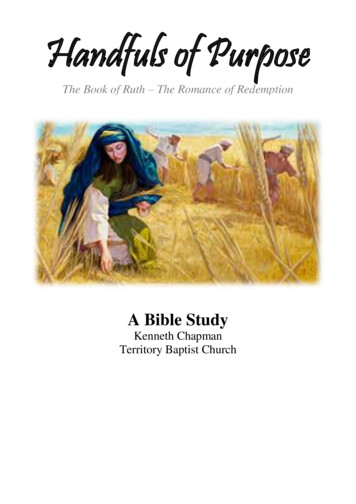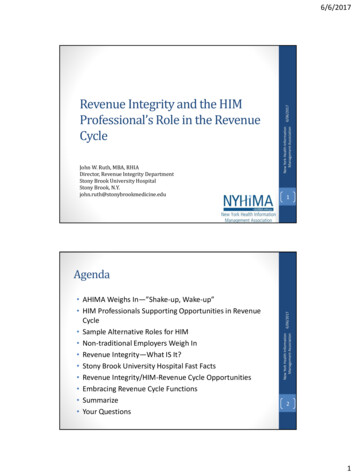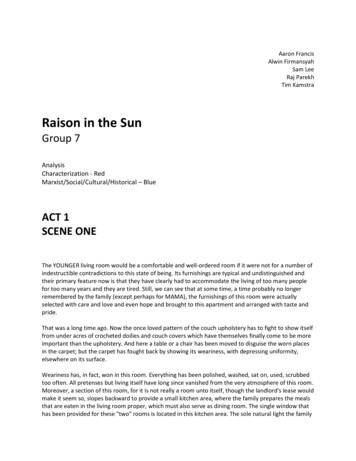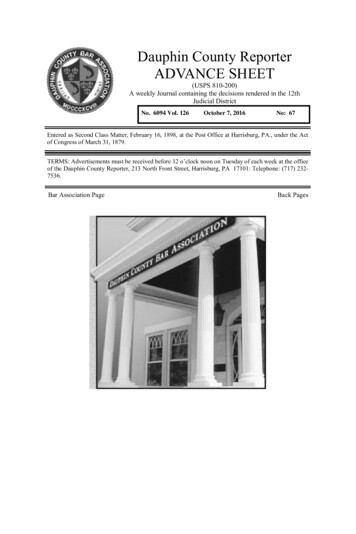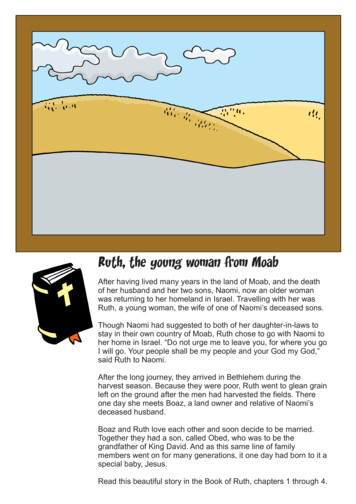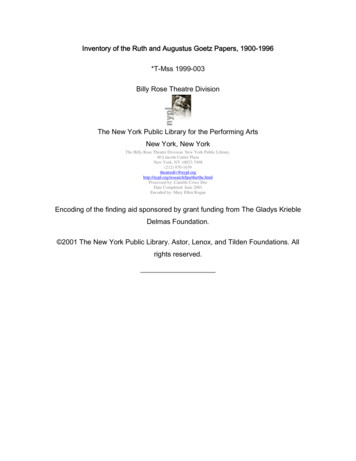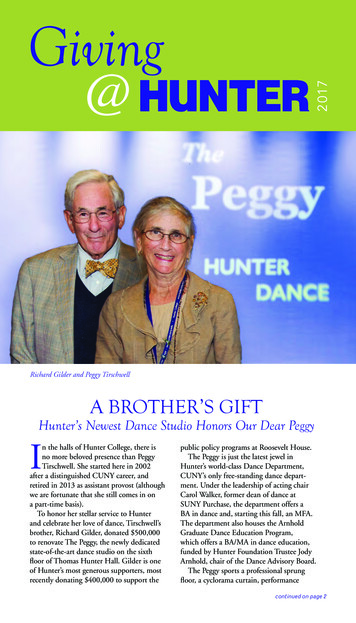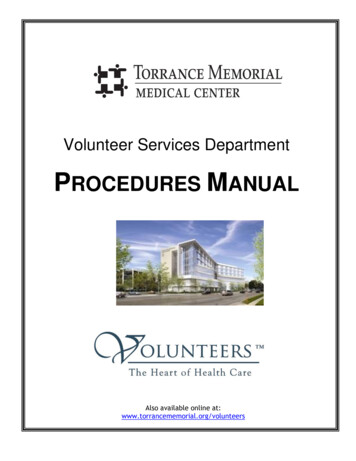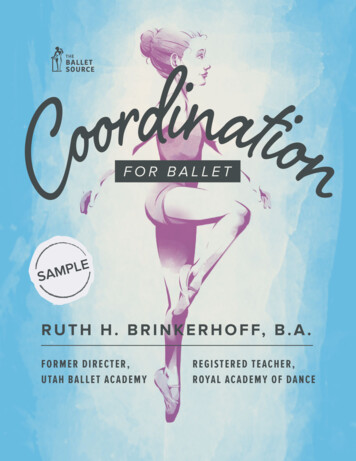
Transcription
FOR BALLETLEPMSAR U T H H . B R I N K E R H O F F, B . A .F ORME R DIREC T ER,UTAH B A LLET AC A DEM YREGISTE RE D TEACHE R,ROYAL ACAD EMY OF DAN C E
Coordination for Ballet The Ballet Source, 2017.Cover design and illustrations 2017, Eric Hungerford.All rights reserved. No portion of this book may be reproduced, stored in a retrieval system, or transmitted in any form or by any means, electronic, mechanical, photocopying, recording, orotherwise without the prior written permission of the copyright holder.THE TEACHER MUST DECIDEand safe for any particular teacher, class, orstudent. It is the responsibility of each balletteacher to use his or her best judgmentin applying the information and teachingsuggestions contained herein, and in usingthe activities, dances and teaching materialscontained in this book and others in TheBallet Source series.The Ballet Source series of manualsprovides information, activities andsuggestions for the teaching of ballet tochildren. The materials in these books haveworked well for the author, and for otherteachers of her acquaintance. However,the author cannot know what approach orwhich physical activities will be appropriateGo to Index2TheBalletSource.com
Welcome to Coordination for BalletTHIS BOOK IS INTENDED FOR USEWITH STUDENTSAGE SEVEN AND OLDER.Todays children are not as physically activeas in previous generations, especially ininformal play settings, such as singinggames, folk dances, and other traditionalplay activities, such as “London Bridge”,“Tag”, “Hide and Seek”, “Farmer in the Dell”,etc.For suggestions about what to use withyounger students, consult the teachingmanuals from The Ballet Source, Levels 1,2, and 3.When a dance student seems to be behindin coordination, correction on how tomove, such as teaching them to skip, willnot help very much. Forcing a particularcoordination skill may actually prevent theoverall improvement that you really want tohappen.Coordination is a natural developmentthat should be allowed to happen on itsown, whenever possible. This will usuallyoccur when the young child is free to movethrough the natural movement patternsintended by nature. (See pages 8 and9). These movements also need to bepurposeful, or intended, by the child tohappen, or to result in something the childwants to do. (See page 10)All students need to strengthen andimprove their physical coordination tosome degree. They need to strengthenand practice the basic natural movementexperiences because these are what formsthe base for ballet technique.This book provides the dance teacher withsuggestions for natural and purposefulmovement activities that can be included ina ballet class. These activities should helpstudents improve their coordination, andalso be a fun break from the technique ofballet. Use them about midway through theclass.Study pages 5-9 before using the activitiesand dances. Select the ones you feel willbe fun for the class to do. If you think theyare fun, and convey this feeling to the class,they will most likely enjoy doing them!Coordination is programmed by natureto be a natural part of every person’sphysical development. It will nearly alwaysdevelop on its own when given sufficientunpressured opportunity to do so.Go to Index3TheBalletSource.com
Table of ContentsI. Background InformationIntroduction6Coordination?—Where Does it Come From?8The Pyramid of CoordinationThe Pyramid ExplainedDance Teachers Can Help!II. Things To DoTeaching Planned MovementPre Skipping SkillsActivities to TryStory Activities, or Dances For FunFolk Dances Can Help!III. More About CoordinationHow The Brain Gets its Act TogetherBrain Development, Sensory InputGrowth StagesIV. MusicMusic ListMusic for the Folk DancesMusic for the ActivitiesPURCHASE COORDINATION FOR BALLET
Introduction to Coordination For BalletDISCLAIMER:WHAT IS NEEDED FOR BALLET?When the dancer is not responding to theactivity or exercise in the way that youwould normally expect them to, they mayneed a medical expert to check for possiblestructural or neurological difficulties. Whenthe dance exercises don’t produce theexpected results, consider suggesting aclinical evaluation by those that know more.The complex and advanced coordinationpatterns used in classical ballet require:a strong, secure foundation of naturalcoordination,kinesthetic awareness, both of self andof the world around that self, andan ability to learn which muscles tosignal for the various positions andmovements in classical ��———————PURPOSE OF THIS MANUALThat’s a big order. The miracle is that somany students actually succeed in learningso much of this very demanding art form!The activities suggested are intendedto help students age eight1 and older toimprove their coordination, as needed forballet.GUIDELINES FOR USING THISMANUALThese activities are not therapeutic. Danceteachers are not medically trained, and donot offer therapy in any form.1. Use what the students enjoy doing.Create your own versions of the activitiesif this works better.The good news is that the ballet teachercan select dance activities for class thatshould improve the students’ coordinationfor ballet.2. Watch for noticeable improvementin about 12 weeks. Movement habitsseldom change much in less time.Teachers should pay attention to theTeaching Notes preceding the exercises.These are to help you know the generalintent of the activity, and to help youpresent it successfully.3. If they cannot learn or respond to anactivity after two weeks, drop it. Trysomething more basic, something thatwill lead up to the result you are after.4. Don’t call attention to a student’sshortcomings— they already know theyare “uncoordinated”, and may have deepfeelings about it.Each teacher is different, just as each classand student is different from all others.Adjust the work and the suggestions toblend with your own personal style ofteaching, yet not losing the intent andeffectiveness of the work.5. Teach safely. For injury prevention , andbest motor skill improvement:For help with younger ages, we recommend the Ballet Arts For Young Children and Classical Ballet manuals from The Ballet Source.1Go to Index5TheBalletSource.com
If it hurts, don’t do it. “Hurt” means pain,not the gentle stretchy feeling that issometimes felt with dance movements.Dance is hard work, but it should also becomfortable and fun.6. Teach with a positive approach. Praise,encourage, compliment the class. Avoidgiving special attention to individualsunless you give it to each member ofthe class. Teach the class as a unit, eventhough each student has a different set ofabilities.7. The parents’ attitudes affect a student’sview of their abilities. Assure parentsthat dance lessons usually do help, butit will take time. Coordination problems,especially in a dance class, are normal,and do not indicate that anything is wrong.8. Coordination activities added to theballet classwork will strengthen thecoordination of every student. The entireclass will benefit. The class can do theseactivities as warmups, or as fun breaksfrom technique, partway through the class.9. Keep it simple. Tough challenges do nothelp. Contrary to popular opinion, a toughchallenge only makes the problem worse.10. This book contains a sampling of danceactivities that can help dance studentsimprove their coordination as it relates toballet and other dance forms.Go to Index6TheBalletSource.com
Coordination—Where Does It Come From?There is no “magic bullet”, no one exercisethat will solve all coordination problemsfor all students, within just a few lessons.But, the good news is that we can make adifference!HOW DO YOU KNOW IF ASTUDENT IS “UNCOORDINATED”?Most people, when asked to explaincoordination, refer to the use of armsin opposition when walking, running,marching. They may also mentionnot running into things, having one’smovements under control, not lookingclumsy, etc.COORDINATION ISDEVELOPMENTALEach stage of development is built on thefoundation of all of the previous stages.All of the stages overlap. It is an extremelycomplex process that is programmed bynature into each and every one of us.This manual will assume that normalcoordination is actually present in everyperson. Those who appear uncoordinatedsimply lack movement experience, or theircoordination has not been used enough tobecome secure and observable in somemovement situations. For example, imaginea person knowing how to drive a car, butwho doesn’t practice it enough to pass thedriving test!When a new stage of developmentstarts, all of the previous stages must bereinforced and strengthened at the sametime the new stage is being learned.As adults, we have the potential for allof the basic patterns of coordinationwithin us. All stages of development areconstantly being used as is appropriate tothe situation, and they are continually beingstrengthened by this use.As dance teachers, we want this unusedcoordination to become an observable partof the student’s outward behavior.It is hard to be patient with this process. Wewant our classes to look good. We wantstudents to learn the material, and to looklike they have learned it. Not only that, ourartistic sense that knows how the finisheddance product should look, wants it tohappen now!LEARNING BALLET ISDEVELOPMENTALIt, too, is a very complex process! Balletalso requires that previous learnings bereinforced and strengthened whenever anew skill is learned.As dance teachers, we are also dancers,performers, artists. Any awkwardness orlack of observable coordination grates onour sense of artistry like an unresolvedmusical discord.Go to IndexExample: Before building a house, youmake a plan. A house begins with afoundation. A certain strength in thefoundation is needed in order to·support aone story house.7TheBalletSource.com
Purposeful movement is not accidental orrandom, but has been “planned” mentallyby the person, to accomplish a movementand a result that the person wants tohappen.Later, if you wish to build a second storyon top of that same house, you have tostrengthen the foundation so it will notcollapse from the extra weight. And,you must also extend and refine theconnections involved: electrical, plumbing,heating, etc.HOW DOES COORDINATIONHAPPEN?That’s exactly what we do in the teachingof ballet. In teaching the grand battement,we do not stop doing the battement tendu,and the battement degagé or glissé. Theunderlying, smaller movements mustcontinue to be strengthened and refined inorder to support the new skill of the grandbattement.“Coordination” or “Motor SkillDevelopment” is programmed into thehuman body. It is programmed to happenwithout instruction. It will happen if enoughof the appropriate natural movementexperiences are available all during thegrowing years, most particularly from birthto age 8.Strong grand battements lay thegroundwork for beautiful grand jetés. All ofthe movement skills in ballet are connectedto each other. The advanced skills aredependent upon a strong foundation ofbasic skills.When coordination has not fully developedin an older student, it can usually beremedied by providing some of themovement experiences that would havepromoted its development in earlychildhood.These basics are never discarded.They are continually being refined andstrengthened for as long as the dancerdances.Coordination is simply “teamwork”between the muscles involved in amovement, and the conscious thoughtsof the individual. This is true whether themovement is familiar, or new.Providing for the child, teen, or adult toimprove their coordination is no differentfrom providing for them to learn the skillsneeded for good ballet.Certain patterns of movement that arerepeatedly used become habits that nolonger need detailed instructions from thebrain, but are stored as complete units inthe motor area of the brain, and can beset in motion by a single intent from theperson’s conscious brain.The process is the same; the material maydiffer according to need, but the processis the same, and the two learnings can andshould happen side by side.WHAT IS COORDINATION?Riding a bicycle is a standard example ofusing movement patterns that are learned,and which operate as habits or learnedreflexes.Movement coordination is the observableresult of motor skill development. Motorskill development is the observable result ofpurposeful movement experiences.Go to Index8TheBalletSource.com
This teamwork develops in sequentialstages, each new level building on thefoundation of all previous levels. Weaknessat any level can cause a weaknessthroughout the entire system.the brain is busy collecting and organizinginformation gathered by the body’s sensorysystems; and it is busy turning randommovement into planned, purposefulmovement.Coordination begins when the infant firstdiscovers that he or she can use the handas a tool to reach, touch, take hold ofsomething.When an older person allows some of theirmovements to be random, they appearuncoordinated.“Trial and error” movement is OK in anew, unlearned skill, but it is not what weconsider usual in skills that are used often,such as walking across a room and avoidingthe furniture; or opening a door withoutrunning into it.IT CAN BE A LIFETIME OFLEARNING!Coordination never stops improving. Recentresearch has finally admitted that thebrain never stops learning and improving.Since motor skill development involvesteamwork with the brain, it follows thatour coordination can continue to improvethroughout our life.Trial and error are a part of the learningprocess, and need to not be correctedall of the time. This is how the brainadds movement planning to the randommovement, and creates coordinationpatterns, and sequences of muscular actionthat work well with gravity.Another fairly recent finding is thatmovement is what stimulates brain activity,and brain development! Perhaps that is apart of why young children find movementto be so much fun!The foundation for coordination ispurposeful or planned movement.In ballet class, mimes and pantomimesthat are discussed, and details of themovements worked out either individually,or as a class, can help students to mentallydirect their muscles. It will take time,probably a few weeks at least, for results tobecome apparent.RANDOM MOVEMENT IS WHEREWE BEGANA newbom’s movements are mostlyrandom, or without conscious purpose.During the first seven or eight years of life,Go to Index9TheBalletSource.com
There is a Pyramid OfCoordination Within UsThere is a Pyramid of Coordination withineach one of us. All stages of developmentoverlap—ages listed may vary betweenindividuals.I. PURPOSEFUL MOVEMENTBegins soon after birth. As a separateobservable stage, it extends to about agetwo. It continues to build and strengthenthroughout life.This is movement planned and directed bythe person’s own thinking processes. Thisis the foundation of all coordination. As theperson increases in ability, motor planningbecomes a more and more important partof the total picture of coordination. Anawareness of self begins here: one’s size,shape, ability to move, ability to control andmanipulate objects and to relate to personsin the immediate environment.2. SYMMETRYAs an observable stage, symmetry extendsfrom about age two to age seven. TheSymmetrical Coordination Pattern emerges.Both sides of the body move in about thesame way, either simultaneously, or inimmediate reversal movements, such aswalking. Balance with gravity is learned andrefined; some aspects of posture begin;an awareness of one’s place in spacestrengthens. With strengthening selfawareness comes the beginnings of selfconfidence and self-esteem.Go to Index3. UNITYAs an observable stage, extends from aboutage three to age six. Unilateral CoordinationPattern develops and complements thesymmetry already in place. This can be seenas the eyes look where the hand reaches,and when the same arm and leg work at thesame time, as when both go forward at thesame time in marching. An awareness ofother persons and of interacting with themis strengthening.4. CONTRASTUsually begins to show up around age fiveto age seven; in some movements, it mayappear much sooner.Contralateral coordination pattern appearsas a result of the three-layer foundationnow in place. This is what most peopleexpect to see. Arms move in oppositionto legs in walking, running, marching. Thethree natural coordination patterns (stages#2, 3, and 4) overlap in their development,and reinforce each other. Some of the basicnatural movements can be combined toform more difficult movements such asskipping.Handedness, and a movement awarenessof right and left come at this level. Forcingsuch responses sooner can be confusingto the child. The ability to fit movements tomusical beats usually happens here. (Lackof muscular control prevented it before.) In10TheBalletSource.com
6. SPECIALIZED MOVEMENT SKILLSballet class, we often err in assuming thispattern will naturally carry over to the dancemovements. No, dance movements belongto levels #5 and #6.About ages 12-17. The person selectscertain skills they want to be really goodat. They will work hard to improve theseskills. All they need is a positive teachingapproach, and a chance to work out thedetails in their own neuromuscular system.Constant demonstration and cueing canprevent them from improving, as it takesaway the need for them to precisely plantheir own movements. Planning is not lessimportant now. Its importance actuallyincreases as each coordination level isadded. Teachers need to not always dancewith the class. Demonstrate, then let themwork it out on their own!5. COMPLEX OR COMBINEDMOVEMENT SKILLSAbout ages 8-11. Now precise movementtraining can be successful. This stage israrely reached before age eight. Combinedcoordination patterns can be learned, butthey must be taught and practiced. Naturalcoordination is in place, making technicallearnings possible, but it won’t happenautomatically. The teaching must be there.And, students must also be given a “trialand error” time, a chance to work out themotor planning they need to make thelearning secure. Let them perfect it on theirown once they have the general idea ofwhat to do.Go to Index11TheBalletSource.com
Thank you!Thanks for taking Coordination for Ballet for a test run!PurchaseHas this complimentary sample helped you? Purchase Coordination for Ballet.FeedbackWe need your help in inspiring the future best in ballet. Bring your ideas to us by filling outour online form or by emailing us at theballetsource@gmail.comFree ContentAs always, enjoy our free content at balletcurriculum.com/blog
expected results, consider suggesting a . 1For help with younger ages, we recommend the Ballet Arts For Young Children and Classical Ballet manuals from The Ballet Source. . groundwork for beautiful grand jetés. All of the movement skills in ballet


